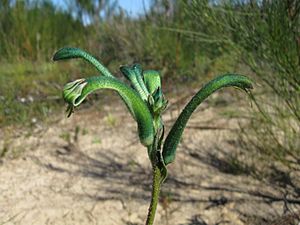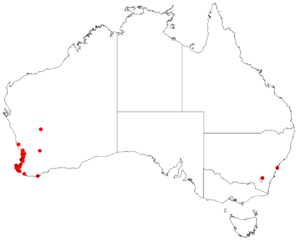Green Kangaroo Paw facts for kids
Quick facts for kids Green Kangaroo Paw |
|
|---|---|
 |
|
| Scientific classification | |
| Genus: |
Anigozanthos
|
| Species: |
viridis
|
 |
|
| Occurrence data from AVH | |
The Anigozanthos viridis, commonly known as Green Kangaroo Paw, is a unique plant found in the southwestern coastal areas of Western Australia. It's called "Kangaroo Paw" because its flowers look a bit like a kangaroo's paw! The local Noongar people have their own name for this plant: Koroylbardany.
Contents
What is the Green Kangaroo Paw?
This amazing plant is a perennial herb, which means it lives for more than two years. It grows from a special underground stem called a rhizome, which helps it spread and grow new shoots. Green Kangaroo Paws usually grow to be about 5 centimeters to 85 centimeters tall. That's like the height of a small ruler to almost a meter!
Its beautiful green or yellow-green flowers bloom in spring, usually between August and October. The only other scientific name for this plant is Anigosanthus viridis.
Naming the Green Kangaroo Paw
Scientists give every plant and animal a special two-part name, like a first and last name, so everyone around the world knows exactly which plant they are talking about. This is called taxonomy. The Green Kangaroo Paw was first officially described by a botanist named Stephan Endlicher in 1846. He wrote about it in a book called Plantae Preissianae.
There are two slightly different types, or subspecies, of the Green Kangaroo Paw:
- Anigozanthos viridis subsp. terraspectans was described by Stephen Hopper in 1987.
- Anigozanthos viridis Endl. subsp. viridis is the original type.
The second part of its scientific name, viridis, comes from a Latin word that means "green." This makes sense because of its green flowers!
Where Does It Grow?
The Green Kangaroo Paw is found along the west coast of Western Australia. You can see it from places like Gingin in the north all the way down to Augusta in the south. It likes to grow in damp areas or places that get wet in winter. You'll often find it in clay, loam, or sandy soils.
Traditional Uses
The Noongar people, who are the traditional owners of the land where this plant grows, used the roots of the Green Kangaroo Paw as a food source. They would either roast the roots or eat them raw.

